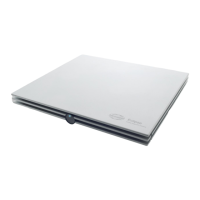Eclipse Additional Information Page 215
10.5 FAQ – DPOAE
Q: The default protocols have been changed or deleted.
A: Remove the DPOAE20 using Windows® “Add or Remove Programs” within the Control panel.
Delete the DPOAE20 folder from your hard drive using Windows® Explorer. The DPOAE20 folder is
placed below the IaBaseII folder on the C drive if the standard installation has been used.
Note You will not delete any recorded patient sessions following step 1 and 2 above! Patient sessions
are saved in the IaBaseII folder. However, do not take any risks. Always backup prior to program
changes.
Reinstall the DPOAE software. Insert the enclosed DPOAE20 CD into your PC. If auto run feature is
on, the installation Wizard will start automatically.
If auto run is not on double click on setup.exe file on the enclosed DPOAE20 CD and follow instruc-
tions.
Q: I do not get a pass checkmark even though the S/N has exceeded the S/N criteria of the test.
A: The pass checkmark is placed only after the DP point has demonstrated its S/N ratio over a preset
amount of time. Also, if the DP point is below -10dB SPL, then the pass checkmark is not placed, as
such low level DP products - despite their potential technical validity - do not carry the same diagnostic
strength as DP products of higher intensities.
Q: The test time seems longer with DPOAE20 than with some screening products.
A: This may be true for several reasons. The DPOAE prioritizes high quality of the recordings, rather than
a short test time. Also, often more frequencies are tested for diagnostics than what is tested for
screening, where the test is typically stopped after only the needed few frequencies have met their cri-
teria.
Q: I cannot get my rejection level down because of much external noise.
A: If no other means are possible in reducing the noise at the source, a standard noise excluding headset
(e.g. Peltor) can prove very effective when placed over the test ear after the probe is in place. Use the
Probe Check function to ensure that the probe still has a good fit after the Peltor is in place.
Q: The cable is rubbing against clothes etc. and thus transmits mechanical noise to the probe, re-
sulting in less than optimal test results.
A: This is a common problem. Considerably better test results can be made if such cable based noise
can be avoided. You may try one of these three options:
Place the probe in the ear such that the cable extents upwards. Then route the cable over the head
with the cable resting on the hair of the patient sitting.
Have the cable suspended from the probe onto a fixed object on a table etc.
Use a clamp of some sort to fix the cable to the clothes of the patient close enough to the probe,
that the cable between the clamp and the probe does not touch anything.
Q: When testing confirmed deaf ears or hard walled cavities, I occasionally get unexpected DP
points that meet the pass criteria.
A: The calculation of the level of the DP point as well as the level of the noise is always in DPOAE sys-
tems based on statistical measures. Such statistics are always prone to errors of chance and the less
data that are used the larger the chance of errors. Therefore, as test times for practical reasons are
relatively short, this risk of error is present, and will in DPOAE20 as well as all other DPOAE systems
result in occasional test results deviating from the actual performance of the ear.
The way to minimize this risk is to change the test protocol to a higher Signal to Noise ratio as the stop
criteria. This will of course have the consequence of prolonging the test time for DPs that are actually
correctly present, as it will take a longer averaging time to minimize the noise enough to reach
this higher signal to noise ratio.
The 7dB Signal to Noise ratio chosen for the default test protocols of the DPOAE20 is a clinically pop-
ular compromise between test time and reliability of results.
If a test is under suspicion of having an erroneous DP point and this will have a consequence for the
diagnosis, the test should be repeated one or more times. This should preferably be done after chang-
ing the test parameters temporarily by use of the Temporary Setup, to hold a higher S/N ratio stop cri-
teria of 10, 12 or 15dB. Alternatively, a special test protocol can be made, testing only the frequency in
question and holding a very high Signal to Noise ratio as the stop criteria.

